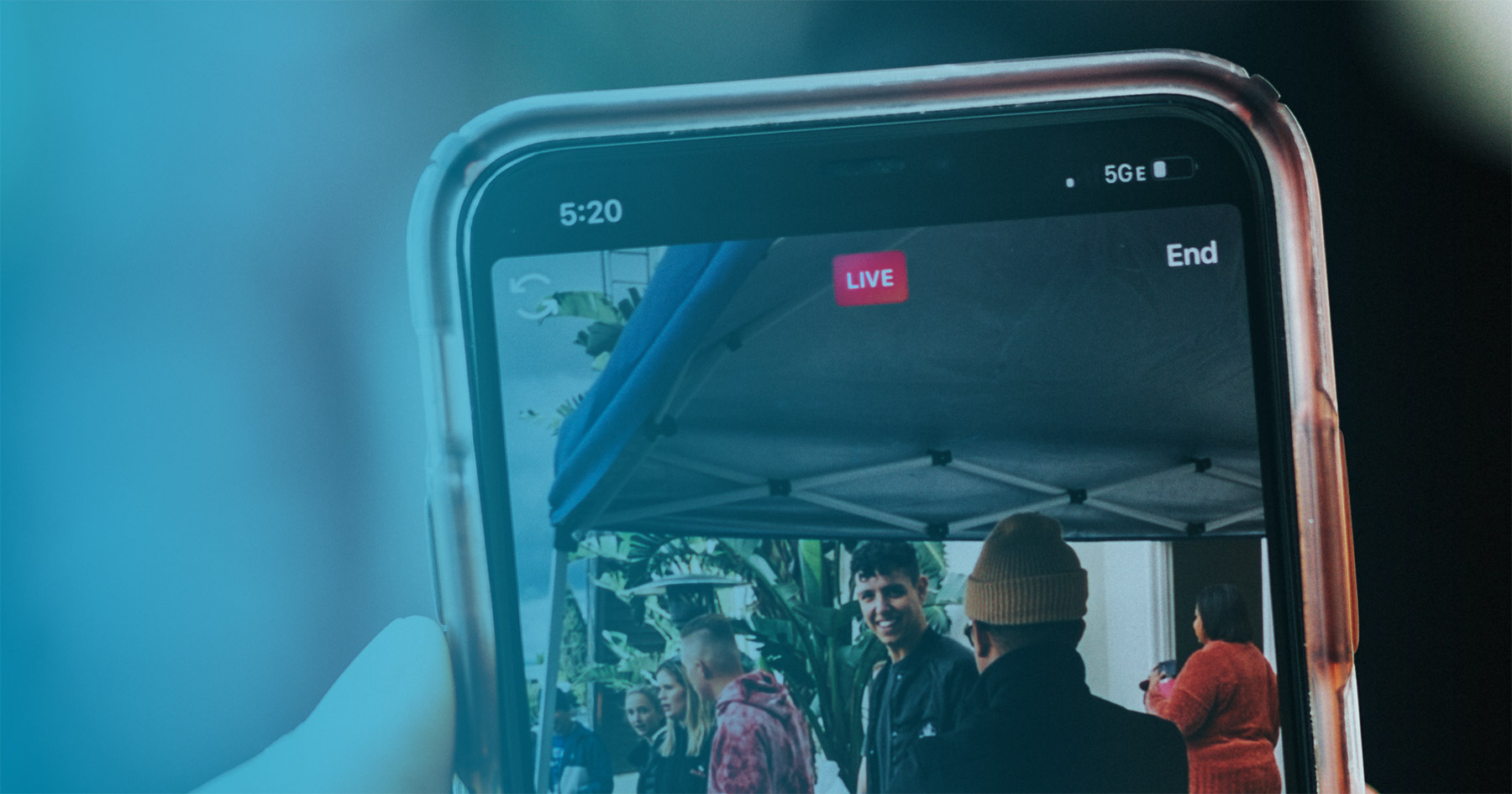Frequently Asked Questions: Livestream on Social Media

Posted By Sara Costello on April 08, 2020
Recently, as the world has been told to #StayHome, live social broadcasts (on Facebook, YouTube, and even TikTok) have been taken to new levels and become a core fixture in this new normal. Social distancing gives these live broadcasts more significance as people look for ways to connect in the midst of widespread isolation.
From Hubspot to Buzzfeed to Slack, many companies are already using live broadcasts to connect with their target audiences via product demos, Q&A, behind the scenes, and even webinars. But before jumping on this trend, it’s crucial brands understand the live landscape and take a thoughtful approach.
FAQ: Where Can Brands Go Live?
With the exception of Snapchat, every social media platform has a live broadcast feature. But just because you can go live, doesn’t mean your brand should. Understanding the audiences and features each of these platforms offers can help you narrow down your options to find the best broadcast spot for your message:
Facebook Live
With 1.7 billion daily active users, Facebook has by far the largest potential audience. And if you’re looking for millennials, you’ll find a lot here: FB’s largest demographic is the 25 to 34 crowd. Keep in mind what kind of content users are looking for on FB: entertaining and informative.
How to get started with Facebook Live.
Instagram Live
With 500 million Stories (home to IGs live broadcasts) posted every day, there is certainly an audience here for vertical video. Eighteen to 34 year olds make up the vast majority of IG’s audience (plus some Gen Z, too). High-performing subject matter here is going to be in the same vein as FB.
How to get started with Instagram Live.
YouTube Live
You’ll be able to reach just about anyone on YouTube as it’s by far the most popular social video platform, and it’s also worth noting that 81% of U.S. internet users ages 18 to 25 are regular visitors. How-tos are among the most watched videos on YouTube, so when in doubt, show, don’t tell.
How to get started with YouTube Live.
Twitter Live
Remember Periscope? It’s still around and allows any Twitter user to broadcast live to their followers, who are likely in the 25 to 34 age group. (Millennials are everywhere!) You’ve probably seen more than a few news broadcasts on Twitter, but audiences are equally eager for demos, product debuts, and Q&As.
How to get started with Twitter Live.
TikTok Live
First, it’s important to note that live is still reserved for accounts with more than 1,000 followers on TikTok. But if you’re looking to talk to Gen Z, TikTok is where you want to be. Be sure to keep your content light, fun, interactive, and short.
How to get started with TikTok Live.
LinkedIn Live
This relatively new feature still has limited access, but anyone can apply. If you’re talking to a professional crowd, it’s worth filling out the form. LinkedIn is the perfect place to broadcast webinars, tutorials, and more, with a professional audience ready to learn.
How to get started with LinkedIn Live.
FAQ: What Technology Should Brands Use (a.k.a. Can I Use My iPhone)?
Live social video is not a format where high-production values are really expected (especially at present). What matters most is having something to say that’s of value to your audience. So don’t let tech anxiety (or the lack of a studio) stop you from going live. Just grab your thought leader with a unique point of view or message, and keep these technical video best practices in mind:
Camera
The answer here is whatever works for you. On a budget? You can absolutely use the camera on your phone. Just log in to the app on your device. A tripod can reduce shakiness and is the simplest and most cost-effective way to give your livestream a professional feel. For something with professional grade quality, think about hiring a videographer.
Lighting
Set up facing a window for natural light and an airy feel that looks professional for zero cost. You may want to invest in a video lighting kit if you’ll be filming in a darker room with minimal windows, or filming frequently. If hiring a videographer, chances are they’ve their own lighting kit ready to go.
Framing
A few years back, social media video was all about the vertical. Today, consider what platform you’re broadcasting to and where your audience will be watching you. For live content on Instagram or TikTok, stick with vertical. And if your audience will be watching you on the go? Vertical. But if they’re going to be tuning in from a laptop or tablet, horizontal will be your best bet.
Regardless of the orientation of your shot, a general best practice is to frame your subject from just below their shoulders up, leaving some space around the top of their head. When showcasing a product during a broadcast, adjust accordingly to make sure your audience is able to see everything they need, but avoid too wide of a frame — a viewer doesn’t need to see the entire room. The key here is to make sure the most important subjects are visible, whether that be a person, a product, or something else.
Sound
If you have multiple subjects in one space or will be moving around a lot, you may need to supplement your device’s microphone with a body mike (i.e. lavalier), but that is by no means required. Airpods or any other headset/microphone setup is a perfectly acceptable option as well.
T1 Tip: For additional tech features, consider using a third-party live application to boost your broadcast on Facebook, YouTube, Twitter, and LinkedIn (Note: Instagram and TikTok don’t yet officially support streaming any outside of their own mobile apps). Tools like StreamYard, Wirecast, and Brandlive allow you to add branding, include more guests in your broadcasts , see additional analytics, and generally have a lot more control over your broadcast than you would have by going directly through any of the platforms.
FAQ: How Can Brands Build an Audience for a Broadcast?
Promote, promote, promote! In this case, social media is your friend. Don’t limit yourself to just sharing your live broadcast on the platform you broadcast on. Promote it on Twitter, LinkedIn, Facebook, Instagram, and anywhere else you can think of in the days and weeks leading up.
Get creative and make sure to use all of your resources:
- Film short teaser clips
- Ask followers to send questions
- Give clues about any surprises (guests, giveaways, contests) viewers can look forward to
- Add a countdown sticker to your IG Stories for an interactive element to get followers amped up.
- Include it in any marketing emails you send
- Let your blog subscribers know
- Ask guests to promote the broadcast to their social followers ahead of time
You have a million ways to build buzz.
And don’t forget paid social media promotions. Even a modest budget will enable you to target certain accounts based on interests, demographics, and events to attract your target audience.
FAQ: What Does Live Success Look Like?
Before going live, think of some milestones you’d like to hit and what matters most to you. Do you care about how many live interactions you can have with your audience? Are you looking for a high number of live views? Knowing in advance what you hope to achieve with your live broadcast helps you determine just how successful your broadcast was.
In a world where more and more people are turning to live social broadcasts for entertainment, education, and connection, brands must be more focused than ever to ensure their content is truly valuable. And by tuning in to what will be most helpful to their audience, they also have the opportunity to create stronger connections than ever before.
Want to get your social strategy primetime ready? We’re here to help you and your business find the right social media marketing plan to meet your business goals. Contact us here to get started.

Sara Costello
Sara Costello is Tier One's Social Media Manager, where she builds engaging, high-performing social media strategies and digital content for clients. She's worked in the inbound marketing space for more than eight years, primarily working one-on-one with clients in the industrial and medical fields. Sara enjoys exploring new ideas for her client's social media presence and collaborating with her colleagues to craft holistic strategies. When she's not in the office, Sara spends her time writing sketch comedy and watching spooky TV shows.



